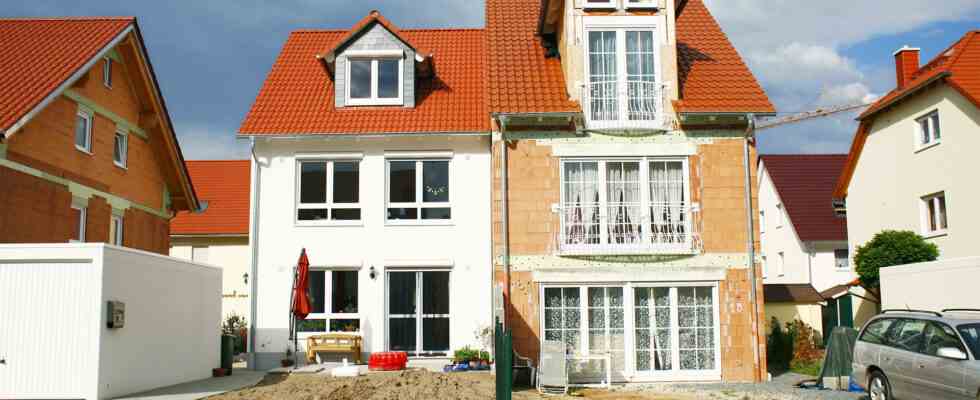Status: 07/16/2022 08:52 a.m
In the low-interest phase of the past few years, the home savings contract seemed to end up in the mothball of the financial industry. But now the number of new contracts is growing again. Consumers are pursuing a clear goal.
The Bausparkassen can currently look forward to a high demand for Bauspar contracts again. At the same time, the principle of building society savings threatened to disappear into oblivion when interest rates on the capital market were zero. The reports of success from the providers of home savings contracts are clear: home savings is again “in” for consumers who want to save money for a property purchase or renovation.
Building societies are happy about new business
In the first five months of the year, LBS Bayern recorded “a growth in new business that has not been seen for decades”; the home savings sum increased by almost 80 percent to 3.8 billion euros. The Wüstenrot & Württembergische had already reported a turnaround in the business with home savings contracts in the spring, one sees “significant growth” in demand. The market leader Schwäbisch Hall has also expressed confidence in the course of business in 2022.
In the time of low interest rates for building loans, but also for savings investments, the boom in building savings of the past decades had taken a long break. Some providers had caused negative headlines by trying to force customers out of old contracts that still had high interest rates. There are still around 25 million current home savings contracts in Germany. In recent years, the possibility of real estate financing at interest rates of less than one percent per year has motivated those interested in real estate to opt for classic financing via bank loans.
Interest rates tripled
But the low interest rates for mortgage loans are probably over in the longer term. Interest rates have been rising rapidly since the beginning of the year. According to the financial consultancy FMH, the average interest rate for ten-year standard loans is currently 2.8 percent. That is three times the interest rate level of last December. Five months ago, the comparative interest rate was 0.9 percent. The fear of increasing burdens due to rising interest rates has now led to a rethink among many property owners and prospective buyers.
The great advantage of the home savings contract now comes into its own again. Because it enables savers to fix an interest rate for a building loan now, even if the loan will only be used in five, ten or 15 years. The principle of building savings provides that a part – usually 30 to 50 percent – of the future building savings sum is accumulated through monthly savings. If the targeted amount has been collected and a minimum savings period has elapsed, the home loan and savings contract is “ready for allocation”. The remainder of the home savings sum is then paid out as a fixed-interest loan from a bank or building society.
Interest rates for a home savings contract still attractive
In practice, building societies are currently still offering interest rates below 2.5 percent for a standard building savings contract, in which a building savings sum of 200,000 is to be mobilized in seven years. For this, 1000 euros must be saved monthly in order to have around 84,000 euros on the high edge for seven years. The loan for the remaining amount of 116,000 euros must then be repaid within ten years.
Home savers also benefit from state subsidies. A housing bonus can be claimed, which pays out ten percent of the annual sum paid in as a bonus, but a maximum of 70 euros for single people and 140 euros for married people annually. The employee savings allowance can also flow into a home savings contract; this is 43 euros per year.
Closing costs and mini savings interest as a disadvantage
However, there are also disadvantages to the advantages of building savings, which savers should be aware of. The Bausparkassen charge between one and 1.6 percent of the Bauspar sum. At 200,000 euros, this would be 2000 to 3200 euros. Future savers should also take into account the low interest rates on the savings rates during the savings phase. The building societies currently offer 0.01 to 0.10 percent interest per year.
The experts at the consumer advice center in Bremen also point out that savers are in a “closed system”. In principle, only funds that have previously been paid in by other savers are paid out as loans. The allocation of the loan is therefore not guaranteed.
Classic mortgage loan cheaper and more transparent
The alternative to home savings remains the classic annuity loan, which is usually more transparent and cheaper than a home savings contract. With a “forward loan”, an interest rate can be fixed several years in advance for an already running loan with follow-up financing.
Those who plan to buy real estate in five, ten or more years can probably invest their savings in call money or fixed-term deposits or in the stock market until then. However, he may then have to accept higher interest rates for real estate financing.

